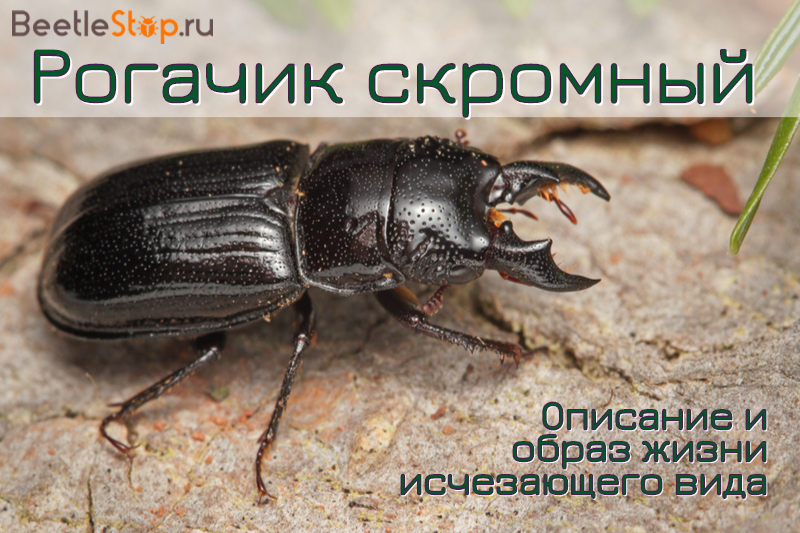A modest stag beetle - a lifestyle of a forest beetle, the reasons for the reduction in the number of insects
Among the representatives of the stag family living in Russia, the most famous species is the stag beetle. The dimensions of the male with mandibles are 85-95 mm. Stag beetle modest or birch barbel is his relative, but can not boast of outstanding dimensions. The beetle 15 mm long has mandibles up to 5-6 mm. It lives in old forests, prefers rotten birch wood. In Europe, the species is listed in the IUCN Red List as being in need of protection.

Morphological description of the species
The stag beetle is modest, small or birch (Ceruchus chrysomelinus) belongs to the winged wing order, the stag beetle family. Beetles of medium size, adult length 12-16 mm. The upper body is convex, the color is black, shiny. The underside is reddish brown. Extremities and club-shaped antennae red-brown. Insects are characterized by sexual dimorphism.
In males, the upper jaws (mandibles) are prominent. Sickle-curved mandibles have an angular protruding tooth. Head transverse in width coincides with clearly carinated pronotum. Parts of the body are tightly interconnected. At the base of the pronotum, two sharp protruding corners. Antennae short, three-segmented mace. The head and mandibles are dotted. The limbs are short and strong.
The head of the female is much smaller than the pronotum, the mandibles are short. Elytra with deep longitudinal grooves and sparse puncture. The lateral parts are parallel, rounded at the apex. Elytra completely hide abdomen and hind wings. On the legs of the forelimbs, a series of spikes, characteristic of the legs of the digging type. Sharp spur on hind tibia. Paws 5-segmented, terminated by two claws.
Distribution area
Birch stag beetle is widespread in Europe, excluding Great Britain. The northern boundary of the habitat runs through the south of Sweden and Finland. Often beetles can be found in the mountain forests of the Alps, Carpathians, in southern Germany. In Russia, insects live in the taiga and forest zone up to the Northern Urals and Tomsk.
Lifestyle
Insects settle in old coniferous and deciduous forests. The beetles have years at the beginning of the summer - June – July. Individual individuals (females) are found in August. Insects lead a daily life. Adults feed on flowing tree sap and flower nectar. Offspring develops in brown wood rot. Mostly birch and spruce are selected, but stag beetles are also found on other trees. Rarely fly at short distances. In flight, males are more often noticed. Larvae and adults fall into a state of winter diapause.
Information. The distribution of birch stag beetle is associated not with climatic zones, but with specific biotopes.
Reproduction and development
Years of beetles can stretch for several weeks. Females lay eggs in trunks and deadwood covered with rot. Embryonic development 2-4 weeks. Larvae are white, the body is soft, fleshy, C-shaped. The head is yellow-brown, the antennae are short, the jaws are well developed. there are three pairs of chest legs. The spiracles are located on the sides of the body. Larvae develop slowly, within 2-3 (according to other sources, 3-4) years. Feeding on dead wood, long passages gnaw out.They contribute to the disposal of rotten vegetation, affect the processes of soil formation. Pupation of larvae occurs in late summer or early fall. Adults live for several months.
Information. The posterity of birch hornbeam is susceptible to the negative effects of fungal infections. A significant percentage of insects die at the pupal stage.
Protective status and limiting factors
The number of representatives of the species Ceruchus chrysomelinus is catastrophically reduced in European countries. This is due to the widespread decrease in the area occupied by old forests. The specific habitat of stag beetles was preserved only in certain areas. Scientists estimate that over 10 years the total number of insects will be reduced by 20%. Limiting factors include poor ability to resettle a modest stag beetle. Beetles fly a short distance. Removing deadwood, old stumps and logs destroy the forage base of the offspring.
The beetle is listed on the European Red List or IUCN Red List in a category close to vulnerable situations. On the territory of Russia, a modest stag beetle is protected in separate areas. The number of insects in the Moscow region decreased to a critical level. Beetles were in the Red Books of neighboring regions: Kaluga and Yaroslavl. In the Moscow region there is only one place where they are found, Solnechnogorsk district. Protected areas are organized in the forest, and the export of birch and spruce dead wood has been suspended.

